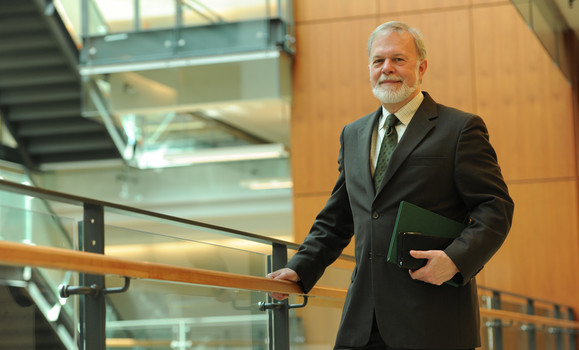Why doesnтАЩt scientific information always flow through the appropriate channels to inform public policy?
ThatтАЩs what Bertrum MacDonald, currently acting dean of the Faculty of Management, and his team with the research program asked themselves before setting the wheels in motion on a new interdisciplinary graduate course.
тАЬOur research is definitely multidisciplinary, because itтАЩs dealing with questions of what happens to marine environmental information in public policy decision-making contexts,тАЭ says Dr. MacDonald. тАЬIt began with looking at major reports that were generated by governmental bodies, and the question was: is anybody reading these?тАЭ
ItтАЩs an important question, one that takes on extra emphasis as Canada enters a period of transition at the federal government level. ╠¤
тАЬThe question of how information is used, particularly in policy and decision making, is not a trivial matter,тАЭ adds Dr. MacDonald.

Spanning disciplines
Drawing on the interdisciplinary nature of the Faculty of Management at Dal, the team developed "INFO 6100 тАУ Role of Information in Public Policy and Decision Making." While Dr. MacDonald is the course lead, other members of the team that helped develop the course include Kevin Quigley (School of Public Administration),╠¤ Peter Wells and Elizabeth De Santo (adjuncts with the Marine Affairs Program) and Anatoliy Gruzd (formerly of the School of Information Management).
After receiving approval to launch their idea two years ago, the course was tested for a year, went through a review, and has now been successfully offered for two semesters. The most recent iteration, which concluded in April, boasted attendance of students from seven different masters programs such as Information Management, Public Administration, Resource and Environmental Studies, Health Promotion, and Engineering. (The course will next be offered in the Winter 2016 term.)
Dr. MacDonald says that the presence of students from varying backgrounds is a testament to the multidisciplinary nature of the course.
тАЬWeтАЩve been receiving very positive feedback from the students,тАЭ he says. тАЬI think itтАЩs now starting to build a reputation because thereтАЩs nothing like it on the campus where weтАЩre grappling with questions of what happens in decision-making and how information flows into decision-making processes.тАЭ
In fact, itтАЩs not just the first course of its kind on the ╣√╜┤╩╙╞╡ campus; it might also be a pioneer on the world stage. ╠¤
тАЬThe part that is really the significant glue for this is the role of information,тАЭ says Dr. MacDonald. тАЬThere are other schools that will deal with the science or the public policy, but none of them are taking those two elements and using information as the means of trying to understand the intersection.тАЭ
Global expertise
The course begins by introducing the concept and practices of evidence-based policy and decision making, teaching students to identify current-day practices in the production and communication of research-based information. From there, students build on this foundational knowledge by outlining and describing activities where science and policy meet, and assess how research-based information and publications are utilized.
In the last leg of the course, students are expected to apply their understanding of course material by identifying and assessing knowledge management practices applicable to policy and decision-making contexts, as well as the best practices for promoting use of research-based evidence in policy and decision-making.
The class welcomes several guest speakers throughout the term to enhance studentsтАЩ understanding of public policy and decision-making. Speakers for the most recent iteration of the course included Janice Graham of the Faculty of Medicine, scientist Bob Fournier, Nature Magazine journalist Daniel Cressey (who joined the class from London), Halifax MP Megan Leslie, historian of science Ian Stewart and several graduate students.
Dr. MacDonald says having those different perspectives is instrumental in the studentsтАЩ ability to understand and apply knowledge from the course.
╠¤
тАЬOne of the things that I noticed when I came to Dal was the size of the campus, which I think contributes to the ability to cross boundaries,тАЭ he says. тАЬNot everyone can walk into an interdisciplinary environment and speak so that it makes the connections, but the speakers and the students have been really great. WeтАЩre excited for what next term will bring.тАЭ

